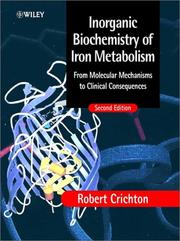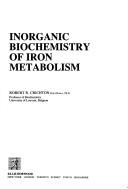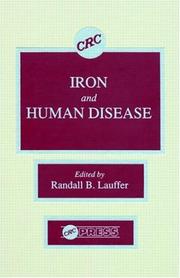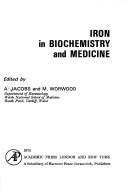| Listing 1 - 10 of 25 | << page >> |
Sort by
|
Book
Year: 2013 Publisher: Bruxelles: UCL,
Abstract | Keywords | Export | Availability | Bookmark
 Loading...
Loading...Choose an application
- Reference Manager
- EndNote
- RefWorks (Direct export to RefWorks)
Hepcidins --- Iron --- Iron Metabolism Disorders

ISBN: 047149223X 9780471492238 Year: 2001 Publisher: New York, NY : John Wiley,
Abstract | Keywords | Export | Availability | Bookmark
 Loading...
Loading...Choose an application
- Reference Manager
- EndNote
- RefWorks (Direct export to RefWorks)
Iron --- Iron proteins. --- Metabolism. --- Metabolism --- Disorders. --- Iron - Metabolism. --- Iron - Metabolism - Disorders.
Book
ISBN: 9535169955 9535106058 Year: 2012 Publisher: IntechOpen
Abstract | Keywords | Export | Availability | Bookmark
 Loading...
Loading...Choose an application
- Reference Manager
- EndNote
- RefWorks (Direct export to RefWorks)
Iron has various functions in the body, including the metabolism of oxygen in a variety of biochemical processes. Iron, as either heme or in its "nonheme" form, plays an important role in key reactions of DNA synthesis and energy production. However, low solubility of iron in body fluids and the ability to form toxic hydroxyl radicals in presence of oxygen make iron uptake, use and storage a serious challenge. The discovery of new metal transporters, receptors and peptides and as well as the discovery of new cross-interactions between known proteins are now leading to a breakthrough in the understanding of systemic iron metabolism. The objective of this book is to review and summarize recent developments in our understanding of iron transport and storage in living systems.
Iron --- Metabolism. --- Iron metabolism --- Iron in the body --- Haematology
Book
ISBN: 1839629983 Year: 2022 Publisher: London : IntechOpen,
Abstract | Keywords | Export | Availability | Bookmark
 Loading...
Loading...Choose an application
- Reference Manager
- EndNote
- RefWorks (Direct export to RefWorks)
Iron is an essential element for numerous fundamental biologic processes. Iron-containing proteins are required for vital cellular and organismal functions including oxygen transport, mitochondrial respiration, intermediary and xenobiotic metabolism, nucleic acid replication and repair, host defense, and cell signaling. However, excess iron is toxic. This book provides a comprehensive overview of the essential role of iron in biology, the regulation of systemic and cellular iron homeostasis, and how imbalances in iron homeostasis contribute to disease.
Iron --- Metabolism. --- Iron metabolism --- Iron in the body
Book
ISBN: 9021903008 0444151893 Year: 1975 Publisher: Amsterdam Excerpta medica
Abstract | Keywords | Export | Availability | Bookmark
 Loading...
Loading...Choose an application
- Reference Manager
- EndNote
- RefWorks (Direct export to RefWorks)
Pathological biochemistry --- Human biochemistry --- Pathology of the metabolism --- Iron --- 577.128 <063> --- metabolism. --- Inorganic and mineral metabolism--Congressen --- 577.128 <063> Inorganic and mineral metabolism--Congressen --- Iron metabolism disorders, Congresses. --- Iron metabolism, Congresses. --- Iron, Metabolism, Congresses. --- Iron. --- Metabolic diseases. --- metabolism

ISBN: 0137287429 9780137287420 Year: 1991 Publisher: Chichester : Ellis Horwood,
Abstract | Keywords | Export | Availability | Bookmark
 Loading...
Loading...Choose an application
- Reference Manager
- EndNote
- RefWorks (Direct export to RefWorks)
General biochemistry --- Iron --- Iron proteins --- Cells --- Metabolic Diseases --- Metalloproteins --- Metabolism. --- Metabolism --- Disorders --- metabolism --- physiopathology --- Iron proteins. --- Disorders. --- metabolism. --- physiopathology. --- Iron - Metabolism --- Iron - Metabolism - Disorders --- Cells - metabolism --- Iron - metabolism --- Metabolic Diseases - physiopathology --- Metalloproteins - metabolism

ISBN: 0849367794 Year: 1992 Publisher: Boca Raton Ann Arbor London CRC Press
Abstract | Keywords | Export | Availability | Bookmark
 Loading...
Loading...Choose an application
- Reference Manager
- EndNote
- RefWorks (Direct export to RefWorks)
Iron - Metabolism - Disorders. --- Iron in the body. --- Iron - Pathophysiology. --- Iron - Toxicology.

ISBN: 0123791502 012378980X 9780123791504 Year: 1974 Publisher: London ; New York : Academic Press,
Abstract | Keywords | Export | Availability | Bookmark
 Loading...
Loading...Choose an application
- Reference Manager
- EndNote
- RefWorks (Direct export to RefWorks)
Iron --- Iron in the body --- Metabolism --- Pathology of the metabolism --- Iron in the body. --- Pathological haematology --- Pathological biochemistry --- Animal biochemistry --- Nutritionary hygiene. Diet --- Metabolism. --- metabolism. --- Iron - Metabolism --- Ferritin
Book
Year: 2015 Publisher: Frontiers Media SA
Abstract | Keywords | Export | Availability | Bookmark
 Loading...
Loading...Choose an application
- Reference Manager
- EndNote
- RefWorks (Direct export to RefWorks)
The iron element (Fe) is strictly required for the survival of most forms of life, including bacteria, plants and humans. Fine-tuned regulatory mechanisms for Fe absorption, mobilization and recycling operate to maintain Fe homeostasis, the disruption of which leads to Fe overload or Fe depletion. Whereas the deleterious effect of Fe deficiency relies on reduced oxygen transport and diminished activity of Fe-dependent enzymes, the cytotoxicity induced by Fe overload is due to the ability of this metal to act as a pro-oxidant and catalyze the formation of highly reactive hydroxyl radicals via the Fenton chemistry. This results in unfettered oxidative stress generation that, by inducing protein, lipid and DNA oxidation, leads to Fe-mediated programmed cell death and organ dysfunction. Major and systemic Fe overloads occurring in hemochromatosis and Fe-loading anemias have been extensively studied. However, localized tissue Fe overload was recently associated to a variety of pathologies, such as infection, inflammation, cancer, cardiovascular and neurodegenerative disorders. In keeping with the existence of cross-regulatory interactions between Fe homeostasis and the pathophysiology of these diseases, further investigations on the mechanisms that provide cellular and systemic adaptation to tissue Fe overload are instrumental for future therapeutic approaches. Thus, we encourage our colleagues to submit original research papers, reviews, perspectives, methods and technology reports to contribute their findings to a current state of the art on a comprehensive overview of the importance of iron metabolism in pathophysiologic conditions.
Iron --- Iron deficiency anemia. --- Metabolism. --- iron metabolism --- iron and genetic disorder --- iron and inflammation --- Heme --- iron and cardiotoxicity --- Iron --- iron and neurodegeneration --- Iron deficiency and anemia
Book
Year: 2015 Publisher: Frontiers Media SA
Abstract | Keywords | Export | Availability | Bookmark
 Loading...
Loading...Choose an application
- Reference Manager
- EndNote
- RefWorks (Direct export to RefWorks)
The iron element (Fe) is strictly required for the survival of most forms of life, including bacteria, plants and humans. Fine-tuned regulatory mechanisms for Fe absorption, mobilization and recycling operate to maintain Fe homeostasis, the disruption of which leads to Fe overload or Fe depletion. Whereas the deleterious effect of Fe deficiency relies on reduced oxygen transport and diminished activity of Fe-dependent enzymes, the cytotoxicity induced by Fe overload is due to the ability of this metal to act as a pro-oxidant and catalyze the formation of highly reactive hydroxyl radicals via the Fenton chemistry. This results in unfettered oxidative stress generation that, by inducing protein, lipid and DNA oxidation, leads to Fe-mediated programmed cell death and organ dysfunction. Major and systemic Fe overloads occurring in hemochromatosis and Fe-loading anemias have been extensively studied. However, localized tissue Fe overload was recently associated to a variety of pathologies, such as infection, inflammation, cancer, cardiovascular and neurodegenerative disorders. In keeping with the existence of cross-regulatory interactions between Fe homeostasis and the pathophysiology of these diseases, further investigations on the mechanisms that provide cellular and systemic adaptation to tissue Fe overload are instrumental for future therapeutic approaches. Thus, we encourage our colleagues to submit original research papers, reviews, perspectives, methods and technology reports to contribute their findings to a current state of the art on a comprehensive overview of the importance of iron metabolism in pathophysiologic conditions.
Iron --- Iron deficiency anemia. --- Metabolism. --- iron metabolism --- iron and genetic disorder --- iron and inflammation --- Heme --- iron and cardiotoxicity --- iron and neurodegeneration --- Iron deficiency and anemia
| Listing 1 - 10 of 25 | << page >> |
Sort by
|

 Search
Search Feedback
Feedback About UniCat
About UniCat  Help
Help News
News